What Is A Blue-Tailed Fly?
If you've heard the 19th century American folk song "Jimmy Crack Corn" and paid any attention to the lyrics, you might wonder about the blue-tailed fly (or blue tail fly) mentioned in the verses.
As the song references brushing away the biting flies from a horse, this blue-tailed fly is likely the horse fly from the insect family known as Tabanidae.
Life Cycle of the Horse Fly (Blue-Tailed or Blue Tail Fly)
Life Cycle of the Horse Fly (Blue-Tailed or Blue Tail Fly)
Like all flies, the horse fly grows through a four-stage process known as complete metamorphosis. Adult female horse flies lay groups of eggs in layers on surfaces such as leaves, rocks and sticks.
After about a week, the eggs hatch into wormlike larvae. Immature larvae feed and grow for up to two years, depending on the species. In spring, the larvae enter a non-active state called pupae. After several weeks, the pupae hatch into mature, winged adults.
Description
Description
With about 4,500 species worldwide, there will be some variation in the size, color and form of horse flies. In the larval stage, horse flies resemble worms but typically have tapered ends with distinct bands around each body section. They range in color from white to dark brown or even green and can grow up to 30 mm in length.
A horse fly pupa is typically dark brown with a hard outer casing. The insect is immobile at this time while the adult is forming beneath the covering.
Adult horse flies are large, gray or black, stout-bodied insects. All flies, including horse flies, differ from most winged insects as they have only one pair of wings. The hind wings on flies have been modified into small structures called halteres. The horse fly species (Tabanus atratus) likely gets its name from its black/purple coloring.
Habitat
Habitat
While adult horse flies, as their name suggest, spend much of their time around large mammals like those found on farms, their larvae prefer a completely different habitat. Adult females lay their eggs close to the water, often on vegetation. When the larvae hatch, they stay in these aquatic habitats, either within or very close to the water.
Once larvae are ready to pupate, they move to dryer locations nearby, usually within the upper few centimeters of soil. Adult horse flies are strong fliers and can be found long distances from their breeding habitats.
Behavior
Behavior
Aquatic horse fly larvae are predators. They feed on small insects and other creatures. Once maturing to adult stage, the male horse fly feeds on flowers.
Adult female horse flies are known for their painful bite. They hide, waiting for a blood meal, which they need in order to produce eggs. Cues such as movement, size and dark colors help the insect find its target, but it is likely the emission of carbon dioxide from a mammal that is most helpful in locating prey.
The horse fly mouth is made up of several parts. The sharp, bladelike, serrated mandibles cut open the skin. Another part, known as the labrum, sops up the blood that pools from the initial bite.
Impact
Impact
While painful to humans, the horse fly bite is not typically dangerous. For livestock such as horses and cows, however, not only are these creatures a nuisance, they can transmit equine infectious anemia and anaplasmosis. Both diseases can cause weight loss and severe fatigue in the animals.
Since larvae live in environmentally sensitive aquatic areas, it is difficult to control the horse fly with pesticides. Livestock can get some reprieve from the biting pests by moving indoors or into a shady area. Horse flies prefer to fly in open spaces and will rarely move indoors.
References
Cite This Article
MLA
Godawa, Jean. "What Is A Blue-Tailed Fly?" sciencing.com, https://www.sciencing.com/bluetailed-fly-5928031/. 22 November 2019.
APA
Godawa, Jean. (2019, November 22). What Is A Blue-Tailed Fly?. sciencing.com. Retrieved from https://www.sciencing.com/bluetailed-fly-5928031/
Chicago
Godawa, Jean. What Is A Blue-Tailed Fly? last modified March 24, 2022. https://www.sciencing.com/bluetailed-fly-5928031/
